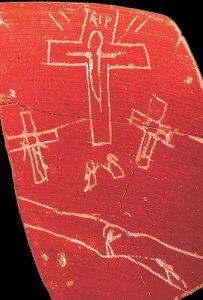Symbolism: The Cross

 A little while ago I wrote a post about the earliest known depiction of the crucixion, the Alexamenos Graffito. During the ensuing Facebook discussion, the subject of the use of the cross in Christian art and worship was raised. This reminded me that I had myself that I would do a blog series on early Christian symbolism.
A little while ago I wrote a post about the earliest known depiction of the crucixion, the Alexamenos Graffito. During the ensuing Facebook discussion, the subject of the use of the cross in Christian art and worship was raised. This reminded me that I had myself that I would do a blog series on early Christian symbolism.
I’ve written before about abbreviations such as IHS and INRI, but I would like to expand upon this by examining early Christian symbols. So with that in mind, I’ve decided to do that today, beginning with probably the best known Christian symbol, the cross.
It may come as a surprise to many people to find out that, in the first few centuries, the use of the cross in Christian art and worship is somewhat unclear. Some historians and archeologists see this symbol throughout the historical record, while others claim that the cross is almost completely absent.
At first glance this might seem strange. Why is there such disagreement? Over the remainder of this post we will see why…

 I have my friends in Washington DC on speed dial. I am only a few clicks away from video chatting with my family in England. I regularly send emails and texts which could wait until we meet in person, but I choose not to delay because of the ease of communication. We live in a world in which we are increasingly connected to one another…
I have my friends in Washington DC on speed dial. I am only a few clicks away from video chatting with my family in England. I regularly send emails and texts which could wait until we meet in person, but I choose not to delay because of the ease of communication. We live in a world in which we are increasingly connected to one another…